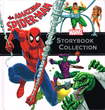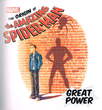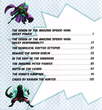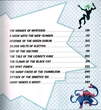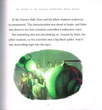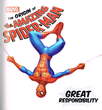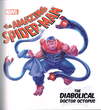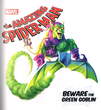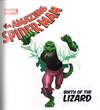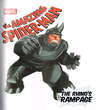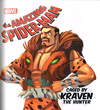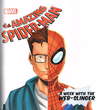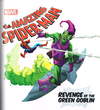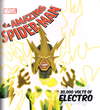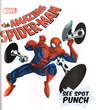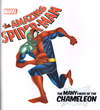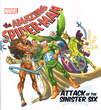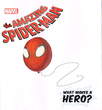The Amazing Spider-Man Origin Storybook Collection (Story 1)
Background
This hardcover book is 9" x 9.5" and contains 300 pages of full-color stories.
When I ordered it, I assumed it was simply a collection reprinting earlier stories. But not at all. Yes, many of these stories do steal the artwork and plots from other sources. But even in those cases, the text has been heavily reworked and adapted. And some of them are entirely new material both in art and plot.
Story 'Origin of the Amazing Spider-Man: Great Power'
The Amazing Spider-Man Origin Storybook Collection (Story 1)
| Publisher: | Disney Book Group, Inc. |
| Adaptation Of: | The Amazing Spider-Man: An Origin Story |
The Amazing Spider-Man Origin Storybook Collection (Story 2)
| Adaptation Of: | The Amazing Spider-Man: An Origin Story |
The Amazing Spider-Man Origin Storybook Collection (Story 3)
| Adaptation Of: | The Amazing Spider-Man vs. Doctor Octopus (Origin Storybook) |
The Amazing Spider-Man Origin Storybook Collection (Story 4)
The Amazing Spider-Man Origin Storybook Collection (Story 5)
| Illustrator: | Craig Rousseau, Hi-Fi Design |
| Adaption: | Scott Peterson |
The Amazing Spider-Man Origin Storybook Collection (Story 6)
| Writer: | Clarissa Wong |
| Illustrator: | Craig Rousseau, Hi-Fi Design |
The Amazing Spider-Man Origin Storybook Collection (Story 7)
| Illustrator: | Hi-Fi Design, Todd Nauck |
| Adaption: | Clarissa Wong |
The Amazing Spider-Man Origin Storybook Collection (Story 8)
| Illustrator: | Craig Rousseau, Hi-Fi Design |
| Adaption: | Elizabeth Rudnick |
| Adapted By: | Marvel Spider-Man: Read and Listen |
| Adapted By: | Spider-Man: Super Hero Tales (Marvel Press) |
The Amazing Spider-Man Origin Storybook Collection (Story 9)
| Illustrator: | Craig Rousseau, Hi-Fi Design |
| Adaption: | Kevin Shinick |
The Amazing Spider-Man Origin Storybook Collection (Story 10)
| Adaptation Of: | The Amazing Spider-Man vs. Mysterio (Origin Storybook) |
The Amazing Spider-Man Origin Storybook Collection (Story 11)
| Writer: | Tomas Palacios |
| Illustrator: | Craig Rousseau, Hi-Fi Design |
| Adapted By: | Spider-Man: Hero Stories (Blue Happy Tin) |
| Adapted By: | Spider-Man: Super Hero Tales (Marvel Press) |
| Adapted By: | Spider-Man: Hero Stories (Parragon) |
The Amazing Spider-Man Origin Storybook Collection (Story 12)
| Illustrator: | Hi-Fi Design, Todd Nauck |
| Adaption: | Steve Behling |
The Amazing Spider-Man Origin Storybook Collection (Story 13)
| Illustrator: | Craig Rousseau, Hi-Fi Design |
| Adaption: | Matt Manning |
The Amazing Spider-Man Origin Storybook Collection (Story 14)
| Illustrator: | Craig Rousseau, Hi-Fi Design |
| Adaption: | Elizabeth Rudnick |
| Adapted By: | Marvel Spider-Man Take-Along Tales: Vulture (Book 6) |
| Adapted By: | Spider-Man: Hero Stories (Blue Happy Tin) |
| Adapted By: | Spider-Man: Super Hero Tales (Marvel Press) |
| Adapted By: | Spider-Man: Hero Stories (Parragon) |
The Amazing Spider-Man Origin Storybook Collection (Story 15)
| Illustrator: | Hi-Fi Design, Todd Nauck |
| Adaption: | Clarissa Wong |
The Amazing Spider-Man Origin Storybook Collection (Story 16)
| Illustrator: | Hi-Fi Design, Todd Nauck |
| Adaption: | Brendon Halpin |
| Adapted By: | Spider-Man: Super Hero Tales (Marvel Press) |
The Amazing Spider-Man Origin Storybook Collection (Story 17)
| Illustrator: | Craig Rousseau, Hi-Fi Design |
| Adaption: | Nachie Castro |
The Amazing Spider-Man Origin Storybook Collection (Story 18)
| Writer: | Bryan Q. Miller |
| Illustrator: | Craig Rousseau, Hi-Fi Design |
The Amazing Spider-Man Origin Storybook Collection (Story 19)
| Illustrator: | Hi-Fi Design, Todd Nauck |
| Adaption: | Scott Peterson |
| Reprinted In: | Marvel Spider-Man: My Spidey Adventure (Storybook & Jigsaw Puzzle) |
| Adapted By: | Marvel Spider-Man Take-Along Tales: Sinister Six (Book 8) |
| Adapted By: | Spider-Man: Hero Stories (Blue Happy Tin) |
| Adapted By: | Spider-Man: Super Hero Tales (Marvel Press) |
| Adapted By: | Spider-Man: Hero Stories (Parragon) |
The Amazing Spider-Man Origin Storybook Collection (Story 20)
| Writer: | Tomas Palacios |
| Illustrator: | Craig Rousseau, Hi-Fi Design |
| Adapted By: | Marvel Spider-Man: Read and Listen |
Let's work through them all in detail.
1: "The Origin of The Amazing Spider-Man: Great Power" is an adaptation/re-writing of the 2011 The Amazing Spider-Man: An Origin Story, which itself was a delicate and beautifully illustrated re-telling of the original Lee/Ditko tale.
2: "The Origin of The Amazing Spider-Man: Great Responsibility" is simply the second half of this story. The artwork from the original tale is used with no major changes. The text is heavily adapted and truncated. The artwork is attractive, and this adaptation is capable and reasonable. Note that Uncle Ben is clearly stated as having been killed in this version.
3: "The Diabolical Doctor Octopus" is an abbreviated adaptation of the 2012 The Amazing Spider-Man vs. Doctor Octopus (Origin Storybook), which is itself a simplified version of Amazing Spider-Man (Vol. 1) #3. This latest adaptation is competent, although it has a nasty habit of beginning paragraphs with "Suddenly" — an irritating flaw which afflicts most of the tales in this book! Also, the "Powerful Punch to the Jaw" ending makes its first appearance here, but not its last.
4: "Beware The Green Goblin" is similarly an abbreviated adaptation of the 2012 The Amazing Spider-Man vs. The Green Goblin (Origin Storybook). The Green Goblin uses the Enforcers to bring Spidey into the open, then capture and unmask him. The usual Norman-reveal, Spidey-escape, Chemical-explosion, Amnesia sequence follows. "Suddenly..." makes its usual appearance.
5: "In The Grip of The Sandman" is credited as an "Adapted" story. It is a very-much simplified, generic and harmless version of the key elements from the original Amazing spider-Man (Vol. 1) #4 with Spidey fighting Sandman at Midtown High School and employing the traditional vacuum cleaner method. The artwork appears to be new for this story, certainly I can't locate any prior use of this art.
6: "The Amazing Peter Parker" is a brand-new story with new art. It's an old theme, though — Peter is required to look incompetent at gym class in order to hide his powers and protect his Aunt May. The story attempts to construct some sort of morality tale from this, but doesn't succeed in doing so.
7: "Birth of The Lizard" adapts and simplifies the 2012 The Amazing Spider-Man vs. The Lizard (Origin Storybook), which is itself a condensed and simplified version of the original Amazing Spider-Man (Vol. 1) #6. This adaptation knocks off all the basic points without going too far wrong in any direction. It's hard to screw up a Lizard story.
8: "The Rhino's Rampage" is adapted from the original Amazing Spider-Man (Vol. 1) #41 with new artwork. It features Peter meeting the lovely Mary Jane, though it omits the motorcycle and also moves the location of the Spidey/Rhino fight to a conveniently located Flushing Meadows. "Suddenly... the door bell rings," and Rhino is knocked out with "a powerful punch to [his] jaw".
9: "Caged by Kraven the Hunter" is also credited as an "adaptation", although I have not been able to determine any specific story which might be identified as the sole source material. In this generic Kraven story, Peter and MJ go to the zoo, where a gorilla escapes. Peter becomes Spidey. Kraven appears and tackles the gorilla first, speaks to the assembled press, then launches into battle with Spider-Man. The web-head wins the day simply by being faster.
10: "The Menace of Mysterio" is a tweaked version of The Amazing Spider-Man vs. Mysterio (Origin Storybook) from 2012. It shares most of the flaws of the original, including the fundamental question of why Mysterio should be considered as a criminal — his only crime being his attempt to arrest Spider-Man.
11: "A Week with the Web-Slinger" is a brand new story and art. It follows Peter/Spidey as he tackles villains and completes his school homework. It's bland and inoffensive enough to escape any serious attention.
12: "Revenge of the Green Goblin" sees Norman Osborn recover his memory and return to his evil Goblin habits. This story adapts some of the elements from the "drug issues" which culminated in Amazing Spider-Man (Vol. 1) #98, including the anti-wall-sticking-gas, and the final scene where the sight of Harry in hospital shocks Norman back to sanity. However the drug back-story is completely absent. Harry is simply "taken ill" for unexplained reasons. Cancer, perhaps?
13: "30,000 Volts of Electro" is a trivial adaptation of the original Amazing Spider-Man (Vol. 1) #9, with Spider-Man wielding rubber gloves and a hose to defeat the shocking villain.
14: "Cry of the Vulture" is a similarly dumbed-down retelling of the original Amazing Spider-Man (Vol. 1) #2, complete with manhole cover appearance, water-tower leap, and Spidey's home-made anti-magnetic gizmo.
15: "The Tale of the Lizard's Rage" sees Curt Connors return to Lizard form, then be lead shortly after into chilled submission in the freezer room of a conveniently placed ice-cream parlour. In that sense, it is technically an adaptation of Amazing Spider-Man (Vol. 1) #45.
16: "The Claws of the Black Cat" sees Black Cat enlist a couple of helpful thugs (named Bruno and Boris as tradition dictates). She breaks into a police station to steal the plans for East River Prison, thus signalling her intent. Cat and friends break into the prison and rescue an engineer named "Gadget" who makes... gadgets for criminals. Spider-Man and the police go to Gadget's house where they find Gadget, Black Cat and her henchmen. It is credited as adapted, presumably due to the elements it borrows from Amazing Spider-Man (Vol. 1) #194-195. It is also utterly moronic.
17: "See Spot Punch" is an adaptation of Spectacular Spider-Man (Vol. 1) #99, but only in the sense that they both feature a white-suited character covered in black teleporting spots. It then turns Spot into a day-time burglar of jewellery stores. Seriously, the guy can teleport! Why doesn't he go at night-time when Spider-Man isn't there to foil his plans.
18: "The many Faces of the Chameleon" is a brand new story. The Chameleon pretends to be Spider-Man, and kidnaps the mayor for ransom. Why bother? Why not just walk into a jewellery story disguised as the manager and help yourself to the nice stuff? This occurs at a parade, where naturally Peter Parker is present to save the day. And take some photos of the ensuing chase that inevitably forms the bulk of this uninspired tale.
19: "Attack of the Sinister Six" adapts the classic tale from Amazing Spider-Man (Vol. 1) Annual #1 (Story 1). Doc Ock assembles the Six, and they fight Spidey one-by-one, before all being defeated. It's not a difficult plot to carry off.
20: "What Makes a Hero" is a mom-and-apple-pie original story which sees Spidey paying tribute to policemen, fire-fighters, doctors and other people who do good stuff. Awww... ain't that touching.
General Comments
With only a few exceptions, these tales are perfectly harmless, simplified versions of classic tales. Yes, they have abandoned any pretence of depth or maturity. But objecting to them is like objecting to Pringles potato chips. We know they're the bland, reconstituted, artificially-flavoured product of a chemical factory. But that doesn't stop kids from enjoying them, and growing fat and lazy on the empty calories.
The best of the bunch would be the two-part "Origin of Spidey" segments, which retain an echo of the magic which surprisingly still inhabits that well-worn tale.
The exception at the other end of the scale is the Black Cat tale. That story is doubly offensive — first for its sheer stupidity of plot, but secondly for completely destroying the original moving story in which the Black Cat rescued her father who was dying in prison. It's like "Barney and Friends sing Mozart's Magic Flute, as a tribute to the Kids of America!"
C'mon guys. Please show a little respect here.
Overall Rating 


Oh, it's bland. It's middle-of-the-road, lowest common-denominator. But it's professionally packaged, lovingly illustrated, and is probably the best of the "Spidey Short Story Collection" books which Disney has produced since it acquired the franchise.
I would give it three webs, except for the Black Cat story, which cannot go unpunished.
Two-and-a-half webs.
